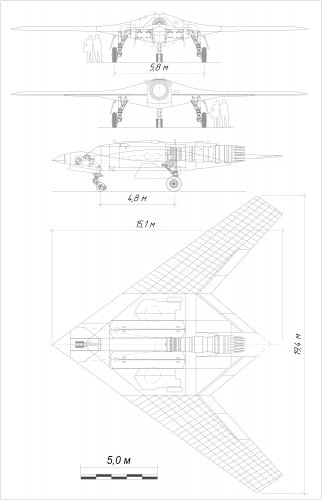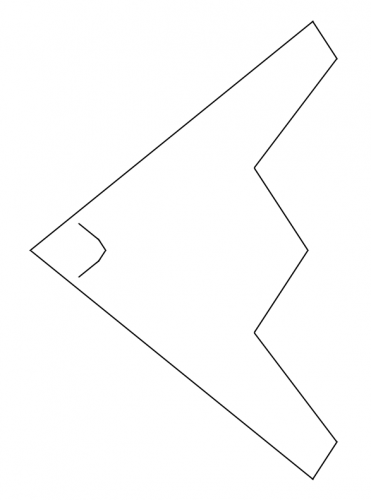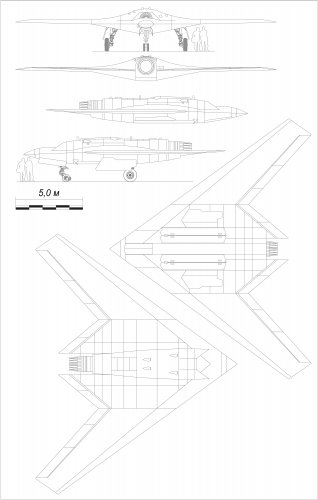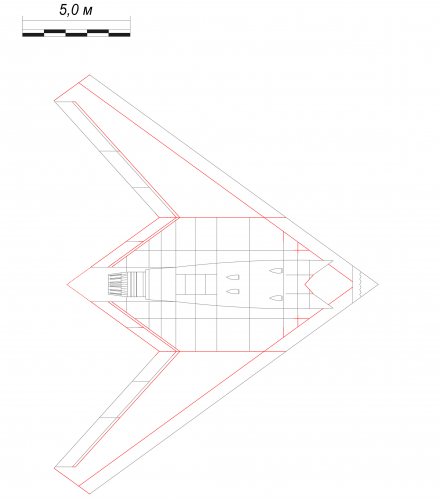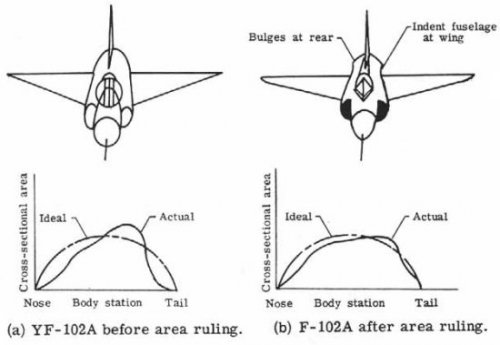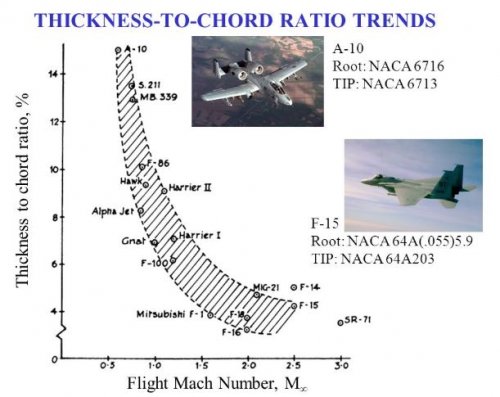You are using an out of date browser. It may not display this or other websites correctly.
You should upgrade or use an alternative browser.
You should upgrade or use an alternative browser.
Sukhoi S-70 Okhotnik UAV
- Thread starter overscan (PaulMM)
- Start date
bipa said:Nice drawing, but from the pictures doesn't it look like the wing has a double sweep ("cranked") like the X-47B ?
Not to me, the mock-up leak and the silhouettes on the Su-57 test bed indicate otherwise too. OTOH my impression is that the intake in the drawing isn't quite right, however. Too far back and the upper lip has an inward triangular "notch" where the Phantom Ray or nEuron have a triangular projection, rather than a straight line as indicated.
EDIT - Like so, if that makes any sense:
Attachments
Nevertheless... Look again at the 4th picture of the opening post by Paul: I cannot figure how a singly swept wing could appear like this.
As to the intake, I think you are right: shape seems to follow the Storm Shadow concept.
As to the intake, I think you are right: shape seems to follow the Storm Shadow concept.
bipa said:Nevertheless... Look again at the 4th picture of the opening post by Paul: I cannot figure how a singly swept wing could appear like this.
As to the intake, I think you are right: shape seems to follow the Storm Shadow concept.
Yes! Storm Shadow - that's where I've seen it before:
https://c1.staticflickr.com/9/8390/8620691837_00b172e4ca_b.jpg
All this time I couldn't put my finger on it.
- Joined
- 4 May 2008
- Messages
- 2,439
- Reaction score
- 762
hmmm...can anyone name a supersonic flying wing of similar configuration?
The absence of one is not proof that it can't be done, but it does raise some questions. Supersonic airplanes need a lot of pitch control to deal with the rearward shift in the aerodynamic center, and flying wings don't have tons to start with.
Also, I have never seen what the cross-sectional area distribution for this type of vehicle looks like, so i don't know what the transonic drag rise characteristics are like either.
I may be wrong but i find it weird that the vehicle is designed for supersonic operations.
The absence of one is not proof that it can't be done, but it does raise some questions. Supersonic airplanes need a lot of pitch control to deal with the rearward shift in the aerodynamic center, and flying wings don't have tons to start with.
Also, I have never seen what the cross-sectional area distribution for this type of vehicle looks like, so i don't know what the transonic drag rise characteristics are like either.
I may be wrong but i find it weird that the vehicle is designed for supersonic operations.
Given that the flying wing volume on a first iteration can be approximated by a planar surface with a given thickness, it's easy to see that the increase in wet volume is something like: h*x*tan(alpha)
With alpha being the sweep angle
x the abscissa on the great axis
h the thickness
If h is fixed then the wet volume increases like tan(alpha) but then if we change h for h(x) and say that h(x) = something * cos(x) we then have for the equation of increase in wet volume: x*sin(alpha)*something (with a smooth section contour).
Here we have a perfect variation for a good low supersonic drag rise (Whitecomb)
With alpha being the sweep angle
x the abscissa on the great axis
h the thickness
If h is fixed then the wet volume increases like tan(alpha) but then if we change h for h(x) and say that h(x) = something * cos(x) we then have for the equation of increase in wet volume: x*sin(alpha)*something (with a smooth section contour).
Here we have a perfect variation for a good low supersonic drag rise (Whitecomb)
- Joined
- 11 February 2010
- Messages
- 1,650
- Reaction score
- 2,703
AeroFranz said:hmmm...can anyone name a supersonic flying wing of similar configuration?
The absence of one is not proof that it can't be done, but it does raise some questions. Supersonic airplanes need a lot of pitch control to deal with the rearward shift in the aerodynamic center, and flying wings don't have tons to start with.
Also, I have never seen what the cross-sectional area distribution for this type of vehicle looks like, so i don't know what the transonic drag rise characteristics are like either.
I may be wrong but i find it weird that the vehicle is designed for supersonic operations.
Or they simply talk about whole different drone. Remember that canopy-less Su-57 model ?
It does have a proper sweep and small wing area.... The question is why would you need it. If you have a UAV flying wing, it can fly in practially undetected, these things are the most easy thing to make very stealthy. The only thing that can come to my mind is to take out important targets. But then it should also have a supersonic fire and forget AtG missile.
djfawcett said:You are mistaking the illusion created by wing twist for sweep change.
Maybe. Twist could indeed create confusion.
On the picture, the wing leading edge has strange perspective and (more puzzling) strange reflections / shadows.
To be more specific, here's the part of the picture where I most distinctly get the impression of a double sweep.
Probably that's just part of me wishing it would be a little cooler than "yet another of those X-45 clones"...
Attachments
bipa said:Maybe. Twist could indeed create confusion.
On the picture, the wing leading edge has strange perspective and (more puzzling) strange reflections / shadows.
To be more specific, here's the part of the picture where I most distinctly get the impression of a double sweep.
Probably that's just part of me wishing it would be a little cooler than "yet another of those X-45 clones"...
I see what you mean now, but it isn't compound sweep - the illusion is created by the air data boom in that picture.
QuadroFX
Russia, Chelyabinsk
My proposed changes in red:
- Storm Shadow-ish notched intake lip, as outlined earlier
- Inboard trailing edge sweep aligned with LE angle (bipa rejoice - AFAIK X-45, nEuron and company have the same angle inboard and outboard, so it's arguably an innovative planform actually)
- wing tip crop aligned with LE angle
While - based on the silhouettes on the Su-57 - I agree that the inboard sweep angle differs from (and does by being higher than) the outboard TE, I doubt Okhotnik really has more than 2 distinct planform angles.
- Storm Shadow-ish notched intake lip, as outlined earlier
- Inboard trailing edge sweep aligned with LE angle (bipa rejoice - AFAIK X-45, nEuron and company have the same angle inboard and outboard, so it's arguably an innovative planform actually)
- wing tip crop aligned with LE angle
While - based on the silhouettes on the Su-57 - I agree that the inboard sweep angle differs from (and does by being higher than) the outboard TE, I doubt Okhotnik really has more than 2 distinct planform angles.
Attachments
- Joined
- 4 May 2008
- Messages
- 2,439
- Reaction score
- 762
TomcatViP said:Given that the flying wing volume on a first iteration can be approximated by a planar surface with a given thickness, it's easy to see that the increase in wet volume is something like: h*x*tan(alpha)
With alpha being the sweep angle
x the abscissa on the great axis
h the thickness
If h is fixed then the wet volume increases like tan(alpha) but then if we change h for h(x) and say that h(x) = something * cos(x) we then have for the equation of increase in wet volume: x*sin(alpha)*something (with a smooth section contour).
Here we have a perfect variation for a good low supersonic drag rise (Whitecomb)
I appreciate the effort to come up with some actual numerical approximation!
That being said, I still have my doubts.
Approximating the minimum drag cross-sectional area distribution of a Sears-Haack body relies a lot on details. Even a good delta wing and fuselage combination, like the F-102A, which has gobs of sweep and wing volume smeared over a long distance in the longitudinal direction, did not achieve good transonic drag rise characteristics until the 'bumps' were added. Short of roughly CADding this and extracting a few cross-sections and measuring their area, it's not something that you can estimate (well, i certainly can't! Whitcomb may have been able...)
For reference, here's the formula of cross-sectional area variation for minimum drag. https://en.wikipedia.org/wiki/Sears%E2%80%93Haack_body. When aiming for planform alignment, and adding the constraint of getting enough elevator area and moment arm for trimming at supersonic speeds, it becomes pretty hard to do. I'm not saying it's impossible, but knowing that some other vehicle had achieved that first would do much to prove the feasibility.
Maybe the TVC on the engine helps with trim? If i had such device on the vehicle, i'd certainly use it for other purposes besides maneuvering.
[edit: D'oh! there's a simpler way of figuring this out. If there's a decent picture of the vehicle that allows you to estimate the thickness-to-chord ratio of the wing, you can see if the airfoil/sweep combination is compatible with supersonic flight. There's a lot of sweep in this design, which means you can get away with some relatively thick airfoil, but it only goes so far. I'll dig up a chart showing the relationship between historical Max Mach vs. thickness to chord.]
Attachments
- Joined
- 29 September 2006
- Messages
- 1,794
- Reaction score
- 1,360
AeroFranz said:Maybe the TVC on the engine helps with trim? If i had such device on the vehicle, i'd certainly use it for other purposes besides maneuvering.
I have a vague recollection that one of the recent books featuring info on old British hypersonic projects mentioned use of vectoring to trim such aircraft. Maybe one of Chris Gibsons? Can't give any more details, too far from my collection :'(
AeroFranz said:Maybe the TVC on the engine helps with trim? If i had such device on the vehicle, i'd certainly use it for other purposes besides maneuvering.
This applies even in subsonic flight:
https://forum.keypublishing.com/forum/modern-military-aviation/140922-ruaf-news-and-development-thread-part-15?p=3848308#post3848308
So maybe that (rather than reheat for supersonic flight or simple expediency) is the reason for the presence of the nozzle. A flat nozzle with TVC could be sufficiently novel that it might prompt a decision to separate FCS testing from it.
DrRansom
I really should change my personal text
- Joined
- 15 December 2012
- Messages
- 701
- Reaction score
- 302
What I don't understand is what is the advantage of supersonic dash capability vs. improved stealth or lower cost. Sure, Russia could get a TVC control assistance for supersonic dash flight, but why go through all that effort?
- Joined
- 29 September 2006
- Messages
- 1,794
- Reaction score
- 1,360
DrRansom said:What I don't understand is what is the advantage of supersonic dash capability vs. improved stealth or lower cost. Sure, Russia could get a TVC control assistance for supersonic dash flight, but why go through all that effort?
Depending on how it is to be employed, I could see a dash being useful in a wingman role, repositioning to cover newly-detected threats. Also could be useful for forcing enemy assets to split their forces to deal with hostiles coming in on widely separated vectors, or even threaten AWACS. Could even be used to cover a retreat - dash at the enemy as the manned asset turns tail.
Would be thirsty on fuel, could leave the UAV gliding on fumes, but in these situations much preferable to losing the manned fighter.
- Joined
- 3 June 2011
- Messages
- 18,339
- Reaction score
- 12,241
starviking said:DrRansom said:What I don't understand is what is the advantage of supersonic dash capability vs. improved stealth or lower cost. Sure, Russia could get a TVC control assistance for supersonic dash flight, but why go through all that effort?
Depending on how it is to be employed, I could see a dash being useful in a wingman role, repositioning to cover newly-detected threats. Also could be useful for forcing enemy assets to split their forces to deal with hostiles coming in on widely separated vectors, or even threaten AWACS. Could even be used to cover a retreat - dash at the enemy as the manned asset turns tail.
Would be thirsty on fuel, could leave the UAV gliding on fumes, but in these situations much preferable to losing the manned fighter.
It's fuel fraction should be much better than any fighter. And if it can supercruise. . .
DrRansom
I really should change my personal text
- Joined
- 15 December 2012
- Messages
- 701
- Reaction score
- 302
starviking said:Depending on how it is to be employed, I could see a dash being useful in a wingman role, repositioning to cover newly-detected threats. Also could be useful for forcing enemy assets to split their forces to deal with hostiles coming in on widely separated vectors, or even threaten AWACS. Could even be used to cover a retreat - dash at the enemy as the manned asset turns tail.
Would be thirsty on fuel, could leave the UAV gliding on fumes, but in these situations much preferable to losing the manned fighter.
Let me make this a bit blunter: are there any published operational research studies on the effect of supersonic dash on aircraft survivability? The whole discussion about supersonic speed keeps going in circles, it is good, but not good enough to always justify the costs. I'd like to know if there is research as to why it is good.
Edit: I have an AIAA article from a Northrop engineer about why stealth is good for survivability and mission effectiveness. But I can't find anything about speed.
- Joined
- 3 June 2011
- Messages
- 18,339
- Reaction score
- 12,241
DrRansom said:starviking said:Depending on how it is to be employed, I could see a dash being useful in a wingman role, repositioning to cover newly-detected threats. Also could be useful for forcing enemy assets to split their forces to deal with hostiles coming in on widely separated vectors, or even threaten AWACS. Could even be used to cover a retreat - dash at the enemy as the manned asset turns tail.
Would be thirsty on fuel, could leave the UAV gliding on fumes, but in these situations much preferable to losing the manned fighter.
Let me make this a bit blunter: are there any published operational research studies on the effect of supersonic dash on aircraft survivability? The whole discussion about supersonic speed keeps going in circles, it is good, but not good enough to always justify the costs. I'd like to know if there is research as to why it is good.
Edit: I have an AIAA article from a Northrop engineer about why stealth is good for survivability and mission effectiveness. But I can't find anything about speed.
See "SR-71 Blackbird".
DrRansom
I really should change my personal text
- Joined
- 15 December 2012
- Messages
- 701
- Reaction score
- 302
sferrin said:See "SR-71 Blackbird".
But we're not talking about Mach 3 vs. Mach 0.9 or even sustained Mach 1.8 vs 0.9, it is more Mach 1.5 temporarily vs. Mach 0.9. I am curious, because the decision for supersonic dash is tempting enough to make designers interested, but not convincing to make the extra expense worthwhile.
- Joined
- 3 June 2011
- Messages
- 18,339
- Reaction score
- 12,241
DrRansom said:sferrin said:See "SR-71 Blackbird".
I am curious, because the decision for supersonic dash is tempting enough to make designers interested, but not convincing to make the extra expense worthwhile.
Okay, see "F-22".
_Del_
I really should change my personal text... Or not.
- Joined
- 4 January 2012
- Messages
- 1,315
- Reaction score
- 1,812
Speed reduces the time spent in a threat bubble from a surface radar or SAM site. Presumably, the frontal rcs would make for small(-er) bubbles to begin with. You also are able to impart more energy at weapons release, so you might be able to increase your stand-off range even farther, reducing or eliminating time spent in a threat bubble. If you have a weapons range of 36km and the defense can detect you at a range of 42km, the less time you spend in that 6km run-in (and egress), the better. Twice the speed (M1.8/M.9) is half as much time spent exposed for them to detect, establish track, maintain lock, and launch. At Mach 1.8, that's under ten seconds to weapons release instead of twenty. Five minute dash capability at 1.5 gives you roughly five minutes to close the final 92kms to weapons release and out again to 128(92+36)kms from target in five minutes. At Mach .9 you chug along taking almost ten minutes for the same route which is extra time for you to run into trouble.
In aerial interception, it makes a much more complicated geometry when introducing maneuvering from the interceptee. Also, being able to put more distance on the map even when losing the race in a tail-chase can be a life-saver, forcing the interceptor to travel a greater distance/time burning more gas, getting closer to or behind you're own line of defense. If he has to expose himself to your IADs, interceptors, manage his fuel load, etc, you stand a better chance of escape.
If it is armed with AAMs, then getting to the right place at the right time becomes important and easier with a dash speed. Imparted energy and weapon range also comes to play here to some degree.
In aerial interception, it makes a much more complicated geometry when introducing maneuvering from the interceptee. Also, being able to put more distance on the map even when losing the race in a tail-chase can be a life-saver, forcing the interceptor to travel a greater distance/time burning more gas, getting closer to or behind you're own line of defense. If he has to expose himself to your IADs, interceptors, manage his fuel load, etc, you stand a better chance of escape.
If it is armed with AAMs, then getting to the right place at the right time becomes important and easier with a dash speed. Imparted energy and weapon range also comes to play here to some degree.
sferrin said:With that wing sweep, assuming area distribution is there, why couldn't it be a supersonic UCAV?
Well, I suppose it's theoretically possible, but isn't the only reason that suspicion about a supersonic capability arose to begin with the nozzle design on this first airframe (which suggested there might be an afterburner)? Flateric has already indicated that, if one is present at all, it's not connected to the fuel system and the full-scale mock-up as well as the outlines painted onto the Su-57 test bed show that the current nozzle isn't here to stay. Of course you can then assume it is capable of supercruise and could therefore still go supersonic with the eventual stealthy nozzle, but isn't that distorting the evidence to fit the hypothesis a bit?
- Joined
- 3 June 2011
- Messages
- 18,339
- Reaction score
- 12,241
Trident said:and the full-scale mock-up as well as the outlines painted onto the Su-57 test bed show that the current nozzle isn't here to stay.
What full scale mockup? Is there a mockup separate from what we've been seeing?
Trident said:Last but definitely not least, the leaked slide which gave us the first public glimpse of Okhotnik showed a configuration (with hindsight probably a full-scale mock-up or RCS test model) that had a perfectly stealthy rear end:
https://www.uasvision.com/wp-content/uploads/2017/08/Hunter-B-project.jpg
- Joined
- 1 April 2006
- Messages
- 11,397
- Reaction score
- 10,314
You may want to return several pages back of the same thread https://www.secretprojects.co.uk/forum/index.php/topic,31319.msg344385.html#msg344385sferrin said:Interesting. It creates more questions than it answers though. For instance, why the nozzle on the prototype? Maybe the engine variant sans afterburner isn't ready yet? ???
- Joined
- 3 June 2011
- Messages
- 18,339
- Reaction score
- 12,241
flateric said:You may want to return several pages back of the same thread https://www.secretprojects.co.uk/forum/index.php/topic,31319.msg344385.html#msg344385sferrin said:Interesting. It creates more questions than it answers though. For instance, why the nozzle on the prototype? Maybe the engine variant sans afterburner isn't ready yet? ???
Were you thinking of a specific post? All I'm seeing is 7 pages of speculation.
- Joined
- 27 December 2005
- Messages
- 17,751
- Reaction score
- 26,427
Plenty of work to do with guidance and control while the final engines are prepared.

